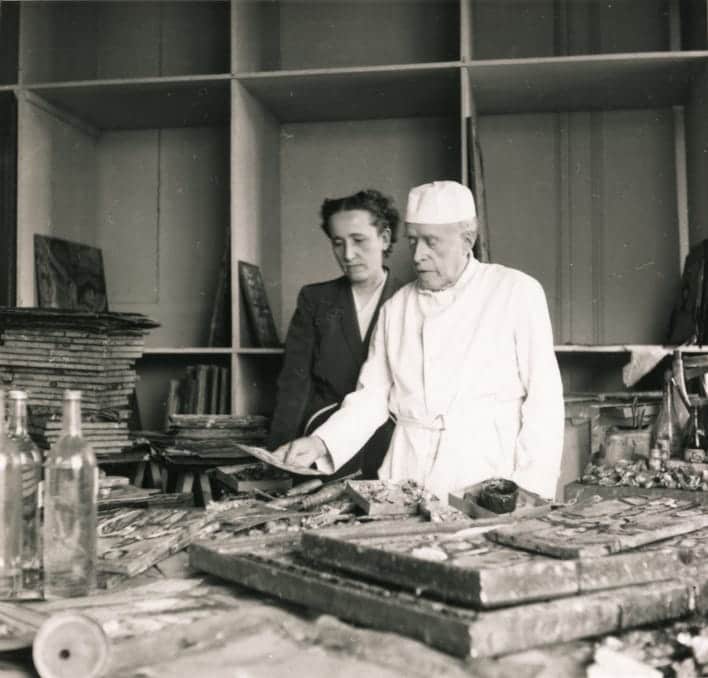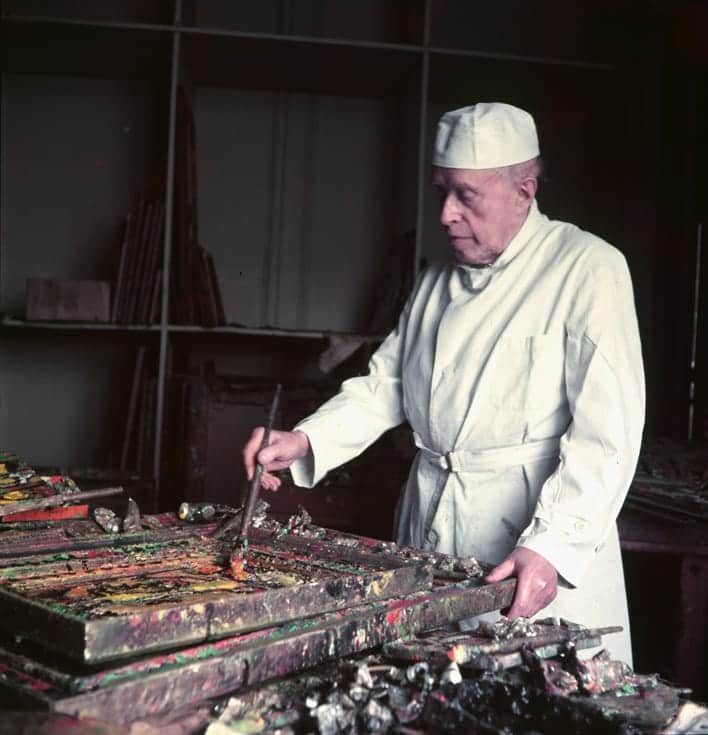Georges Rouault moved to 2 Rue Émile Gilbert in the 12th arrondissement in Paris. During these final years he was assisted by his wife Marthe and his daughter Isabelle who dedicated her life to her father’s work. The apartment come studio where he spent the final years of his life is now the headquarters of the Fondation Georges Rouault.
On 5 November 1948, following his lawsuit with the Vollard heirs, the artist burnt 315 of his paintings in the presence of a public notary. The event caused a stir in the press. He was aged 77 and felt he would not have the time to finish the works.
My eyes are sore from being awake and from trying to choose the works to burn in front of the notary.
Unpublished letter from Rouault to Léon Lehmann, late July 1948


The consecration of his work
Miserere was first presented at the Galerie des Garets from 27 November to 21 December 1948. The exhibition was a great success. The public understood the profound humanity of this work following the horrors of the Second World War.
During the final ten years of his life, the artist received a number of prizes and tributes. Many exhibitions and texts had familiarised the public with the paintings of Georges Rouault. Exhibitions and retrospectives celebrated his work both in France and around the world.
In France, the Centre Catholique des Intellectuels Français organised a tribute to Rouault at the Palais de Chaillot to celebrate his 80th birthday, an event that would be the apotheoses of his career. A national tribute was paid to the artist with a retrospective at the Musée National d’Art Moderne from 9 July to 26 October 1952. In the final room of the exhibition, four newly completed works were exhibited: Nocturne d’Automne(Autumnal Night Fall), Laissez venir à moi les petits enfants(Let the Little Children Come to Me), Crépuscule (Dusk) and Nocturne Chrétien(Christian Night Fall).
A number of events were organised around the world. A large retrospective of 263 works opened in Zurich in April 1948 until June 1948. In 1952, a large exhibition was held at the Palais des Beaux-Arts in Brussels and the Stedelijk Museum in Amsterdam. In 1953, there was a travelling exhibition of the works of Rouault in the United States – at the Cleveland Museum of Art, the Museum of Modern Art in New York, and the County Museum of Art in Los Angeles, followed by the Tokyo National Museum and the Osaka City Museum in Japan. An exhibition was held in 1954 at the Galleria d’Arte Moderna in Milan.

Sacred landscapes are biblical pastorals, sometimes oriental. Dazzling stars sink into the midnight blue skies. Small figures wander here and there, on the banks of a river, on a vague road, between buildings without age nor style. They are uncloaked but their holiness leaves no doubt. They lean into each other and whisper important words in the night.
Unpublished text by Georges Chabot
Rouault received several distinctions including the title of Commander of the Legion of Honour in 1951, the Ordre des Palmes Académiques in 1956 and promoted to the rank of Commander of the Ordre des Arts et des Lettres in 1957.
During these years, Rouault mostly painted colourful and bright landscapes. By 1956 he tired easily and hardly painted at all.
Georges Rouault died on 13 February 1958 at the age of 87. A state funeral was held on 17 February at the Church of Saint-Germain-des-Prés in Paris. He was buried in the Saint Louis cemetery in Versailles.